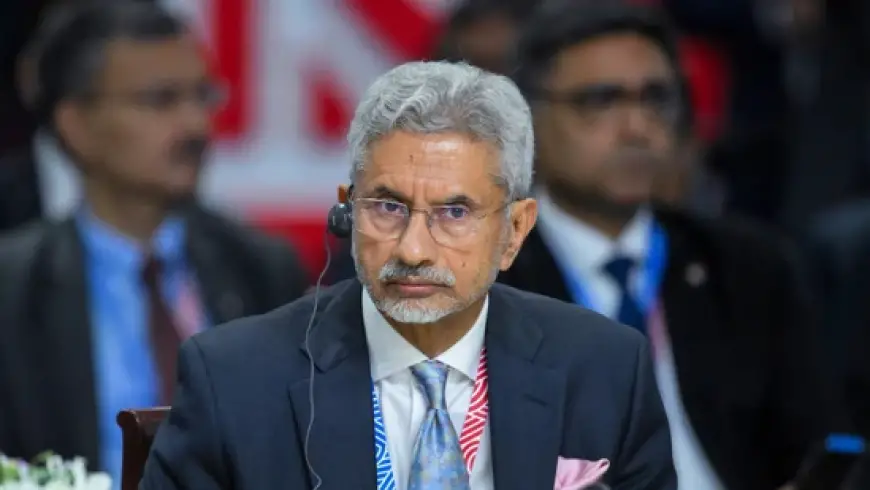Resuming the Diplomatic Tightrope: Jaishankar's China Mission Sees Dalai Lama, Rare Earths, and Ladakh in Play
External Affairs Minister S. Jaishankar embarks on a critical diplomatic mission to China to discuss patching strained ties—from Dalai Lama succession to rare-earth collaborations and easing eastern Ladakh tensions.

1. Arrival Amidst High-Stakes Diplomacy
External Affairs Minister S. Jaishankar landed in China on July 14, ahead of the Shanghai Cooperation Organisation (SCO) foreign ministers’ meeting and a series of bilateral talks. This trip marks his first official visit since the 2020 Ladakh standoff, signalling a delicate yet determined shift towards diplomatic engagement The Express Tribune+13The New Indian Express+13The Economic Times+13.
In a climate charged by Chinese scrutiny of the Dalai Lama succession, Jaishankar’s trip carries broader significance: it seeks to chart progress on contentious issues while probing avenues for limited cooperation.
2. Dalai Lama Succession: A Diplomatic Thorn
China’s eagerness to treat the Dalai Lama’s reincarnation as its “internal affair” has resurfaced in recent public statements, describing it as a lingering obstacle in bilateral relations The New Indian Express. Beijing steers clear of Indian voices influencing Tibetan spiritual matters, rebuking comments from Indian ministers and strategists as meddling.
For India, this succession debate intersects deeply with national sovereignty and cultural identity. Public remarks from India affirm support for the Dalai Lama’s autonomy and spiritual prerogative—fueling China’s unease. Jaishankar is set to navigate a tightrope: backing India’s sovereign position without igniting a wider diplomatic rupture.
3. Negotiating Rare Earth Diplomacy
Alongside political concerns, economic strategy will feature prominently. China controls nearly 90% of the global rare-earth mineral supply, which are vital for advanced sectors like electric vehicles, defense, and electronics New York Post+3The New Indian Express+3Reuters+3.
In recent bilateral dialogues, India pressed Beijing to ease export curbs and establish structured functional dialogues to stabilize supply chains. Ensuring reliable access to rare-earth magnets is fast becoming a national security priority for India, reducing dependence on external sources while bolstering domestic manufacturing.
4. Border De‑escalation: Ladakh Takes Centre Stage
While tensions eased along parts of the Line of Actual Control (LAC) after the 2020 clash, border stability remains fragile. Military and diplomatic channels reinforced disengagement protocols in eastern Ladakh Business Standard+1The Economic Times+1The Indian Express+4India Today+4The Times of India+4.
Jaishankar reiterated in Parliament that calm along the border is a prerequisite for robust bilateral ties. During his visit, discussions are expected to include renewed joint patrols at friction points like Depsang and Demchok, confidence-building measures, and resumption of scheduled diplomatic channels.
5. Trip Context: SCO Amid Fragile Pax Asia
Jaishankar’s visit coincides with the foreign ministers’ conclave of SCO in Tianjin, where cooperation on security, trade, connectivity, counter-terrorism, and data exchange are on the agenda The Times of India+5India Today+5The Times of India+5.
Diplomatic watchers suggest that beyond SCO, India and China may explore resuming Mansarovar Yatra, registering trans-border river data, and facilitating cross-border trade—low-risk yet meaningful confidence-building measures The Indian Express+1Business Standard+1.
6. China’s Diplomatic Messaging
Chinese Foreign Ministry issued firm warnings ahead of the visit, insisting India avoid “playing the Tibet card” and labeling external commentary on the Dalai Lama's succession as “shooting oneself in the foot” Sputnik India+15mint+15Reuters+15.
These reminders reflect Beijing’s sensitivity to diplomatic signals, particularly following Kiren Rijiju’s statements at the Dalai Lama’s 90th birthday affirming Indian civic support for succession autonomy. China interpreted those as crossing into political territory mint+6Reuters+6India Today+6.
7. India’s Delicate Diplomatic Balance
New Delhi’s position is nuanced. While it upholds the Dalai Lama’s spiritual authority and ensures the Tibetan government-in-exile's presence in India, it maintains the One-China policy and avoids overt meddling in Beijing’s internal affairs.
Jaishankar’s early statements stressed India does not take an official stance on religious succession matters. Instead, he emphasized constitutional rights, civil liberties, and the importance of not antagonising over spiritual issues Reuters.
8. Backchannel Trade Gains
Economic diplomacy will build on progress already underway. Chinese Vice-Minister Sun Weidong's recent visit to Delhi produced notifications indicating a functional dialogue on rare-earth diplomacy, visa facilitation, air connectivity, and media interactions Business Standard.
Jaishankar is expected to review this framework, deepen cooperation, and possibly green-light a rare-earth dialogue platform. Restarting direct flights and the Mansarovar Yatra might also form part of a roadmap to restoration.
9. Potential Hurdles Ahead
Despite positive steps, several risks linger:
-
Insufficient disengagement progress: While some patterns of de-escalation are documented, troops remain stationed at other friction points, challenging full confidence-building efforts.
-
Domestic political pressures: Back home, ideological stances will define red lines regarding Tibet. Any perceived concession could invite criticism.
-
Global strategic dynamics: With rising US-China competition, India must align carefully. A Brussels-like pivot is unlikely—India treads a careful non-aligned path through this visit.
10. Conclusion: Rebalancing the India-China Relationship
Jaishankar’s mission represents a measured step forward. It is rooted in a profound shift from confrontation to conditional engagement: avoid consolidation of border tensions, open selective economic opportunities, and defuse cultural flashpoints.
If implemented effectively, the visit could yield:
-
Formal rare-earth supply agreements
-
Stabilised border protocols and fresh patrol routines
-
Restoration of pilgrim routes and visa connectivity
-
A calibrated reset in diplomatic relations, rather than full-blown rapprochement
Yet, success will depend equally on prudence—maintaining spiritual autonomy while reinforcing sovereignty, nurturing economic partnership without strategic compromise, and rebuilding trust one negotiation at a time.
As Jaishankar returns, India may find itself in a more robust posture—politically balanced, economically diversified, and diplomatically alert—to shape the contours of its most consequential bilateral relationship.














